First of all, the hair of a young man sitting in a master’s chair is carefully combed. The instructor confidently promises to demonstrate the entire process of creating a model haircut, while intending to properly use a special machine. The master informs the audience that the side zones of the head should be processed using a machine. It works, periodically changing nozzles on the tool and explaining that it is necessary to obtain a high-quality haircut as a result.
Each nozzle is designed for a specific part of a person’s head, the hero of the video knows perfectly well at what point it is necessary to apply one or another of them. When the master completes the work, the young man with a new haircut looks completely different. When watching a video, it becomes clear that such a haircut is not so difficult, you just need to purchase the appropriate devices and master some of the initial hairdressing skills. Watch the video " Men's haircut, tutorials for beginners in high quality 720 HD. All materials are contained on the Youtube.com service and are available on our website without registration and SMS.
Men's haircuts are traditionally considered easier to perform than women. Roughly speaking, this is indeed so (if you do not take into account creative and trendy options), so many video tutorials for novice hairdressers are devoted to cutting using a machine - a professional device that can now be bought in any hypermarket.
The benefits of male haircuts at home
There are several reasons why men do haircuts at home.
- Saving
The simplest calculations show that the amount of money spent on a minimum set for a home hairdresser (combs, scissors, a hair clipper, spray gun, etc.) is less than the amount that an average man leaves in the salon for a year. - Convenience
If your family needs a haircut, you can help them at any time of the day or night. To do this, they do not even need to leave home or coordinate their schedule with the hours of work of a trusted master. - Availability
With the proliferation of Internet technology, there is no longer a need for a number of training courses. Of course, hairdressers who want to achieve excellence in their field will not do without video lessons: they need to adopt various techniques from professionals, and this is only possible in the format of offline training. However, for beginners and video enthusiasts, lessons on making model haircuts are the most convenient option. - Earning opportunity
If before you decided to do your first men's haircut at home, the hairdresser’s talent was dozing, you can eventually start providing paid services at home. Of course, between the moment when you first watch video tutorials for beginner hairdressers, and the first client’s call a lot of time will pass, since you need to gain experience and knowledge.
Before you arm yourself with a clipper or scissors to make your first men's haircut, listen to the following recommendations.
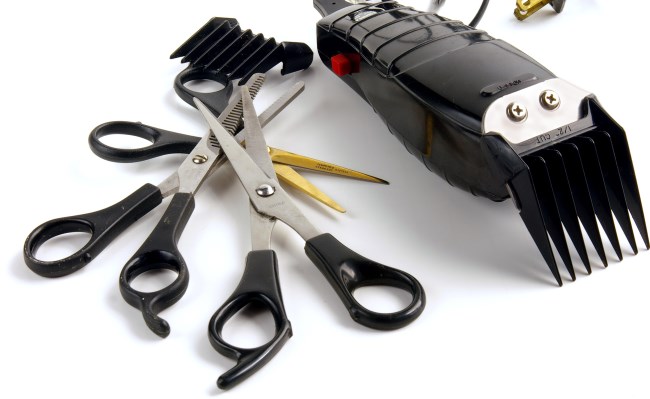
Below are video tutorials that will help you get acquainted with the basics of men's haircuts and the simplest, but fashionable models. We wish you success!

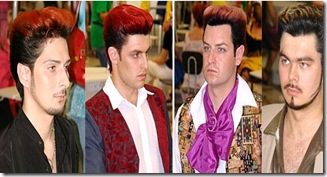
This chapter is devoted to classic, model and creative men's haircuts.
The pages provide examples and types of different men's hairstyles.
Regardless of your age, you can choose one or another fashionable men's hairstyle, and find out in detail how a haircut is done.
This information will be useful for both beginner hairdressers and hairdressing professionals. A novice hairdresser will be able to learn the technology for performing such men's haircuts as, a simple men's haircut, graded caret, men's haircut sport style, or such popular men's haircuts as boxing, half-boxing or a “hedgehog” haircut, etc., and a professional hairdresser once again check your knowledge, or find something new to improve your skills
All men's haircuts are provided with a full description and pictures.
Choose, watch, experiment - everything is in your hands!
Simple men's haircut
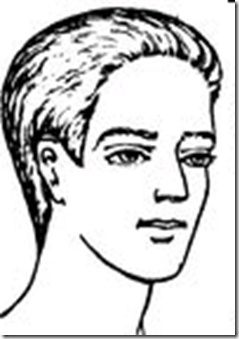
Hair: not too thick.
Tools for performing simple men's haircuts: straight scissors.
Mastery Level: Beginner.
This is a neat, not very short male haircut, performed by lock by lock method.
The essence of this simple men's haircut is that the length of the hair throughout the head is the same.
Such a simple men's haircut can be performed even by one who has never held hairdressing scissors in his hands.
To do this, before starting a simple men's haircut, he will have to read some pages of the site,
to see how to properly hold hairdressing scissors, which means the method of cutting hair strand by strand,
direct cut (methods of processing strands of hair) and hair extension by 90 °.
Performing a simple male haircut
Before starting a haircut, moisten the client’s hair, comb the hair. It is better if you do not just wet your hair, but wash it.
In men's haircuts, they wash their hair twice: at the beginning of a haircut and at the end of a haircut.
Divide hair into zones. To divide the hair into zones, draw vertical partings from the frontal cavities to the border line on the back of the head.
These partitions should be parallel.
Perform a sagittal parting, and you will get six zones: the parietal zone, two temporal zones, the middle occipital and two lateral occipital.
In the parietal zone at the edge of the hairline, select a lock of hair, cut a lock of hair at a distance of 3-4 cm from the roots. This lock of hair will be the control. The entire parietal area is sheared by strand by strand with a hair extension of 90 °.
We sink to the whiskey. The control strand is at the edge line of hair growth in the face. Partitions are vertical, temporal zones of the shear, as the parietal. You are standing behind the client.
Thus, we cut all the hair of the temporal zones by lock-to-lock method until the sagittal parting.
The occipital part of the hair is sheared, starting from the central zone. The control strand is on the sagittal parting.
Let me remind you once again that all simple men's haircuts are performed by the method of strand after strand with a hair extension of 90 °.
Also shear the lateral occipital zones.
Comb all the hair of the back of the head.
We carry out a fringing of hair on a nape. When combing your hair, try to squeeze the hair to your neck as tightly as possible.
If the hair is dry, moisten the hair. The neck edging can be oval, in the form of a trapezoid with straight or rounded edges. The edging line should not be higher than the edge line of hair growth.
To improve the quality of the edging, do not be lazy, comb the hair several times, each time checking the evenness of the line and adjusting the edging line as necessary.
The piping line behind the ears runs almost at the very base of the ear. Before reaching the earlobe, it connects to the neckline. The temple is straight.
Now comb all the hair of the parietal zone forward. Border the bangs. The fringing of the bangs should be straight. You will cut about 0.5 cm, but not more. Now round it a little to the frontal cavities, connect the fringing line of the bangs with the temples.
I advise you to comb your hair at the temples many times and in different directions, checking and removing excess hairs. After such a check, the edging line will become ideal, and a simple men's haircut will look good.
TIPS OF THE MASTER-HAIRDRESSER
Test for a new comb: run the teeth in the palm of your hand. If you get scratched, your hair will feel the same way.
Good brushes have mixed bristles, it consists of natural and artificial components.
These brushes are ideal for nightly 100-fold combing, which is still recommended by professionals.
The control strand of hair in the parietal zone of the face 3-4 cm long
For the middle occipital zone, the control strand of hair is on the sagittal parting
Go down to whiskey
Swift the lateral occipital zones, as the middle zone of the hair, by strand by strand method
Straight neckline
The fringing of the bangs is performed by a direct cut, the fringing line of the bangs is slightly rounded towards the frontal cavities

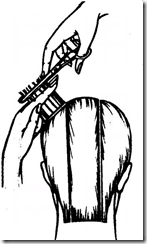
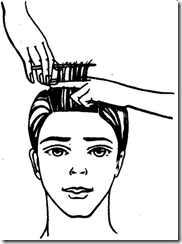

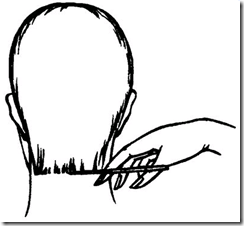

Men's haircut made by a hair clipper.

Hair: Short, Better Stiff.
Tools for performing male haircuts: machine, thinning scissors.
Mastery Level: Beginner.
Men's hair cutting with a machine requires skill, therefore, at the first attempts to cut it is better to leave the hair more authentic.
Cut hair with free slow movements.
Cut a small amount of hair first.
When doing a haircut, comb your hair more often.
Performing a male haircut with a hair clipper
Perform this men's haircut on dry hair. Using the largest nozzle, cut the hair of the parietal zone, descending slightly to the temples.
To do this, comb the hair by height, and enter the machine into the hair against hair growth. We do a lot of movements with the hair clipper, drive the machine along the head, pressing it to the surface, but we do not change the angle with the surface of the head.
From how many times we comb the hair and run the machine, it will depend on how accurately and accurately the male haircut will be performed: the more the better.
Now cut the back of my head. For cutting the nape, use a smaller nozzle, about two times (that is, if the crown was cut with a 12 mm nozzle, then the nape is 6 mm or 9 mm). Starting the haircut from the bottom, we drive the machine up, and if at first the machine is firmly pressed to the head, then at the crown the machine comes off the head, equalizing the difference between the hair length.
Using the same nozzle, cut the whiskey, while combing the hair in different directions.
And now the hardest part. Remove the nozzle from the machine. Your task is to make a smooth transition from the parietal zone “to nothing”. We make a smooth transition from short haircove at the borderline to the hair trimmed before.
We carry out the edging of the temples, behind the ears and neck with a machine without a nozzle.
We use simple scissors to check the length of the hair all over the head.
Thinning scissors on a comb eliminate all inaccuracies and irregularities in the men's haircut.
TIPS OF THE MASTER-HAIRDRESSER
The most important and most problematic part of the machine is the knife. The knife in the hair clipper consists of two parts: movable and fixed.
Knives get dull over time. It is recommended to grind the knife at least once every two years, without waiting until the knife is completely dull and it will have to be replaced with a new one.
We begin to cut the crown from the face, use the largest nozzle
The neckband is performed with a machine without a nozzle.
Haircuts on the back of the head and temples are done with a machine with a smaller nozzle
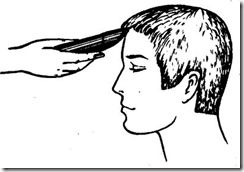
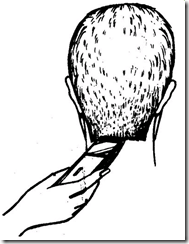
![]()

Short male haircut on a comb.
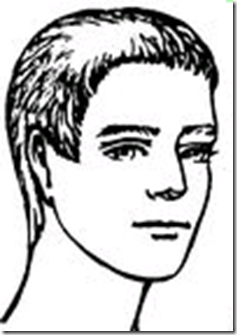
Hair when cutting on a comb: thick, medium thickness.
Tools for performing male haircuts on a comb: straight scissors, comb.
Mastery Level: Beginner.
If your client asks him to make a very short male haircut, but you don’t have a clipper, this haircut is exactly what you need.
All haircuts can be done with only straight scissors and a classic comb.
It is better if the client’s hair is thick and not thin and so that he has recently worn the same short haircut.
Performing a men's haircut on a comb
Depending on the thickness of the hair, this men's haircut can be done on dry or wet hair.
Dry hair is more convenient to cut, but dry hair dull the scissors and it is difficult to create a smooth transition on the hair. Our advice, if the hair is very thick, start a haircut on dry or slightly damp hair, and at the end of the haircut, moisten your hair and do a check.
We start this men's haircut on a comb by combing all the hair according to their natural growth.
Swift the parietal zone, moving from the face to the back of the head on the comb. We introduce a comb into the hair against growth, cut the hair directly above the teeth.
The back of the head is sweeping from the bottom up. To avoid “ladders”, comb the hair at a slight angle and do a check, removing all the extra hairs sticking out over the comb.
It is best to do checks in crossed directions at the back of the head. To do this, we lead first from the left side of the edging line towards the right temple at an angle, and then vice versa - to the right to the left temple. It is necessary to cut only the broken hairs.
We pass to a hairstyle of temples. Whiskey cut from bottom to top, then from the face. Often at the temple closer to the crown of the head in men, hair grows from the face and slightly down. Remember that we always introduce a comb against growth and cut off the hair above the butt.
We check the area between the temple and the crown moving from bottom to top (as when cutting the temples) and from the face (as when cutting the crown).
Create a border line. The temple is straight. We remove everything that sticks out behind the ear. The edging is soft, with rounded corners. All hair below the edging is removed with a razor. If there is no razor, then with the tips of scissors, but in any case, be very careful not to injure the client. For the edging line in this men's haircut, the guideline should be natural hair growth.
If in addition to straight scissors you have thinning scissors - great. Wherever you get a barely noticeable ladder, treat the ends of your hair with thinning scissors.
This men's haircut on a comb emphasizes the natural beauty of a man - especially the shape of the skull, facial features, ears, hair texture and the boundary line of their growth. That is why such a man's haircut requires careful execution.
Swift the parietal zone from the face to the back of the head
The nape of the swift from the bottom up
We pass to a hairstyle of temples
Create a border line

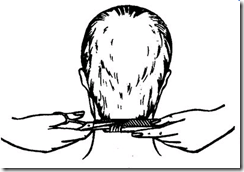
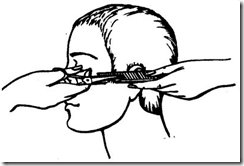
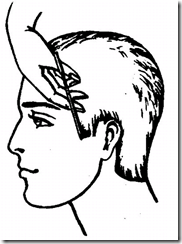
Classic men's haircut.
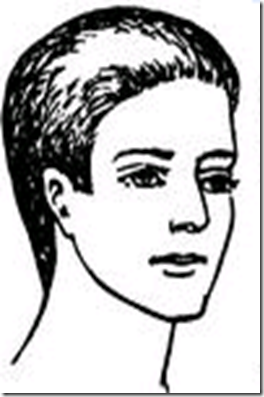
Hair when performing a classic men's haircut: any.
Tools for performing classic men's haircuts: straight scissors.
This male hairstyle is classified as a classic style.
Strands of hair of moderate length are laid from the face, the temple is open straight. This style is loved by many men of any age.
There are a lot of options for haircuts for men in the classical style. Perhaps having studied a few, you will come up with your own haircut technique.
And this option, the classic men's haircut in our opinion, is the easiest to carry out.
Performing a classic men's haircut
Before starting a classic men's haircut, divide clean wet hair into zones.
We start the classic men's haircut with the right temporal zone. In parallel to the edge line of hair growth with a diagonal parting, we select a strand of hair, first we comb it on the face and cut off the corner of the temple to the face. We comb down and perform a fringing of the temple. The temple should be straight.
With a horizontal parting, we select a strand of hair at the temple, we pull it off at an angle of 90 ° and cut with a straight cut. So in a row, highlighting the strands with horizontal partings, cutting all the strands of the temporal zones first from the right, and then from the left.
Next, cut the hair strands of the upper, and then the lower occipital areas with the removal of hair on the fingers.
A reference will be just cut hair strands of the temporal zones.
The occipital region is sheared in the direction from right to left from ear to ear so that each subsequent strand is perpendicular to the head and equal to the previous one.
The lower occipital area is also sheared with vertical partings, with a guy line 90 °, cut the strand at an angle of 45 °.
We carry out a fringing of hair of the lower occipital zone and behind the ears.
TIPS OF THE MASTER-HAIRDRESSER
Brushes, as a rule, are more elastic than combs, brushes less damage hair and gently massage the scalp.
To clean a high-quality brush with mixed bristles from your hair, do not scrub it with a comb - it is better to rub two brushes against each other or buy special "rake" in the hairdressing supplies store just for this purpose.
TIPS OF THE MASTER-HAIRDRESSER
Combs and brushes should be washed regularly with lukewarm water with shampoo. Brushes with wooden handles or rubber bases should not be kept in water during cleaning. After rinsing thoroughly, put the brushes to dry on a towel with bristles down.
We select a strand of hair with a diagonal parting, comb the strand to the face and perform a fringing of the temple
With a horizontal parting, select a strand of hair at the temple and cut with a straight cut
A reference point for the upper occipital zone is the newly trimmed locks of hair of the temporal zones
Symmetry control with a classic men's haircut in front
Control strand of hair for the parietal zone at the temple
Unification haircut between the crown of the head and temporal zones
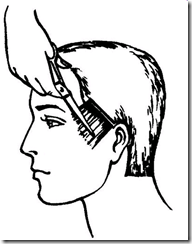

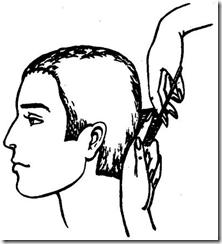
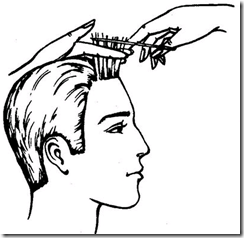
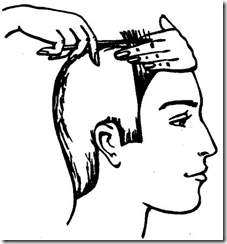
Men's haircut "polka".
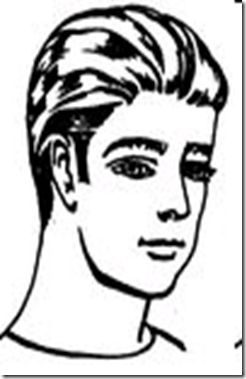
Hair when performing a male haircut "Polka": any.
Tools for cutting "Polka": straight scissors.
Mastery Level: Beginner.
This men's haircut "Polka" is made in a classic style.
A feature of the "Polka" haircut is the volume at the temples.
When styling, all hair is usually combed back.
“To nothing” by a shear only the lower occipital zone of hair.
The edging line of the temples is dense.
The hair on the crown of the head and temples is the same length.
The Polka men's haircut is good for older men or those who have noticeably less hair on their temples than on their crown.
Performing a male haircut "Polka"
We carry out cutting of the strands of the parietal zone with the removal of hair on the fingers
To do this, we select a strand of hair parallel to the forehead hairline near the forehead with a horizontal parting, comb out the strand perpendicular to the head and the haircut, leaving a length of about 3 cm.In parallel with this strand, select the next one, comb it along with the previous perpendicular to the head and the haircut at the level of the previous strand.
So in a row, highlighting locks of hair with horizontal partings and combing them perpendicular to the head, cut at the level of the previous lock the entire mass of hair of the parietal zone, and first the middle part of the parietal zone, and then the lateral parts.
Separate the upper occipital region of the hair from the lower horizontal parting. The mass of hair of the lower occipital area by a shearing technique is “no to” removal.
Strands of hair of the temporo-lateral zones on the right, and then on the left side, cut the hair removal on the fingers with the method. To do this, parallel to the edge line of hair growth of the temporal-lateral zone, select a strand of hair with a vertical parting and comb it onto the face, perform a border, focusing on the length of the strands of the parietal zone. In parallel with this strand, select the next one, comb it out together with the previous one and cut it at the level of the previous strand. So in a row, highlighting the strands with vertical partings and combing them together with the previous one perpendicular to the head, cutting at the level of the previous strand the entire mass of hair of the temporo-lateral zones.
Strands of hair of the upper occipital area with a shearing technique removing hair on the fingers, focusing on the length of the strands of the parietal zone and temporo-lateral zones.
Moreover, cutting hair strands is done in rows.
The final stage of the Polka men's haircut is the haircut trim.
We trim the hair with straight scissors, after wetting the hair or combing it with a wet comb.
Control strand of facial hair 3 cm long
Lower the occipital area of \u200b\u200bthe hair is reduced to "no"
Select a strand of hair at the temple, comb out the strand on the face and perform the edging
Trimming the temporal zones is carried out by removing the hair on the fingers, focusing on the parietal zone
Strands of hair of the upper occipital area with a shearing technique
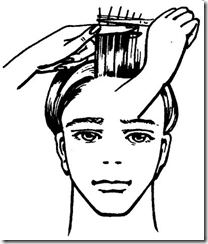
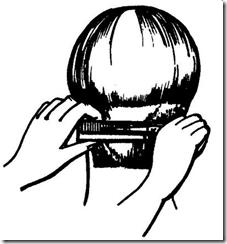


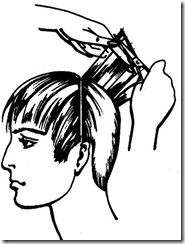
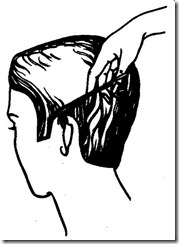
Men's haircut "half boxing."
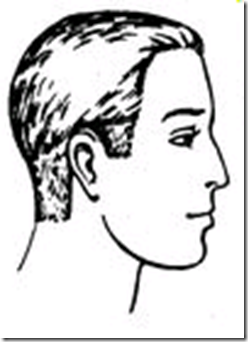
Hair when performing a half-box haircut: any.
Tools for performing male half-box haircuts: straight scissors, hair clipper.
Skill level: ability to cut with a machine without a nozzle.
The essence of the semi-boxing haircut method is that the part of the temporo-lateral zones and part of the occipital zone is trimmed by taking the hair “to nothing”, and the cutting of the parietal zone is performed by removing the hair on the fingers. The male half-box haircut has two fringes: one fringing - along the edge line of hair growth, the other fringing - along the upper edge of reducing the hair “to nothing” on the temples and nape.
Performing a male haircut semi-boxing
We begin to carry out the half-box haircut from the center of the occipital zone, first to one, then to the other side, strip after strip, by the method of “nullifying” the hair clipper or razor.
If you use a machine, then the hair may be dry, when using a razor, you must always moisten your hair with water.
The upper boundary of the treated area runs along the line of the upper point of the auricles and occipital tubercle (to the center, it is somewhat omitted).
If you are not sure that you can make a straight line with a machine, first use scissors for this.
At the temples, the hair is sheared, taking into account the level of the previously trimmed occipital zone.
After that we make a fringing of hair on the neck, temples, behind the auricle.
In order for the transition from short to long hair to be softer, a very smooth shading of the hair should be performed 2-3 cm above the control line. In this case, you can use straight and thinning scissors, a razor.
Then the hair of the parietal zone is sheared on the fingers and lightly milled hair.
During haircuts, shading, thinning, it is necessary to work on the shape of the half-box hairstyle, trying to veil all the imperfections of the appearance and, if possible, give the half-box hairstyle the correct oval shape.
The back of the head with a sweep machine "to nothing", creating a border line
We make smooth shading of the hair of the control line
A whiskey with a haircut, focusing on a trimmed nape
The hair of the parietal zone with a shear on the fingers, moving from the face
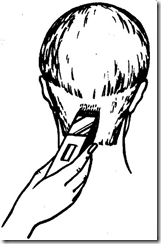
![]()


Men's haircut "boxing."
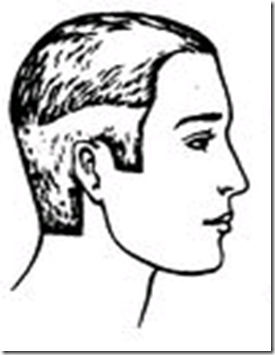
Hair when doing men's haircuts boxing: any.
Tools for male boxing haircuts: straight scissors, hair clipper.
Skill level: the ability to work with a hair clipper without a nozzle.
A box haircut, unlike a half box haircut, has shorter hair, and the border of the hair edging passes above the occipital tubercle.
In a haircut, the boxing border of the hair trim can be at different heights and have a different shape (taking into account the shape of the head and hair growth).
This haircut is preferred by young people with the correct shape of the head.
More accurately, the men's haircut boxing will look on not too black hair.
Boxing haircut
We mark with the straight scissors the boundary of the transition from long hair to short ones.
If the whiskey is very hollow, the hair line can be made lower, if the whiskey is quite convex, the hair line can be raised higher. If the back of the head is very convex, then the fringing of the hair should pass under it.
We reduce all the hair to this line “to nothing” with a hair clipper.
We carry out a fringing of hair all over the head with a machine or razor.
The hair of the parietal zone is sheared on fingers by strand by strand method.
Then we thoroughly shade the hair of the edging line (with thinning scissors, a razor).
The width of the hair shading strip can be different and depends on the color of the hair. With dark hair, hair shading should be wider than with fair hair.
Work on the hairs on the face with a toothed cut, comb the hair on the face and cut off all the protruding hairs with the tips of the scissors.
Nape with a hair clipper to the control line “no” to the control line
The parietal zone by the strand by strand method, the control strand in the face

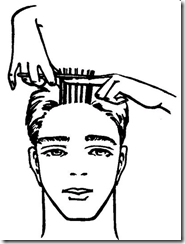
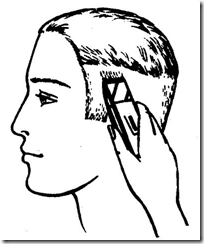
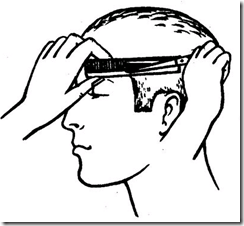
Men's haircut or square.
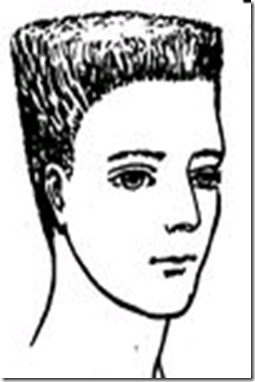
Hair when performing a man's haircut or square: not thin, the hair should keep its shape well.
Tools for performing a man's haircut or square: straight scissors, hair dryer, comb.
Skill level: self-confidence, good haircut skills.
The most difficult stage of this men's haircut is the design of the so-called "site",
which is located on the site from the line of the forehead to the crown and has a strictly horizontal surface.
Creating a perfectly flat horizontal line of the “platform” requires special care.
When cutting, the hair should be in a strictly upright position, and the better the hair is pulled,
the better the men's haircut will be done. The comb and scissors are kept in a strictly horizontal position,
and the scissors, parallel to the comb, move with it, not lagging behind and not ahead of it, to prevent a marriage in a haircut.
Performing a men's haircut or square
Moisten the hair before the haircut with a fixative, give the hair a vertical position and put it in a hairdryer, trying to maintain the shape obtained.
If the hair length exceeds 5 cm, a preliminary haircut should be performed, leaving the hair length about 5 cm, since long hair cannot be fixed in an upright position.
We begin the haircut with the side zones.
When cutting, the hair should be pulled away from the head so that the hair is perpendicular to the intended "site". We move from the face to the back of the head, strictly observing this position of the comb and scissors. So we cut the upper occipital and temporal zones.
We reduce all the hair of the lower zones to nothing, while you can use scissors or a hair clipper.
We proceed to the formation of the "site". We outline the height of the "platform" in the face, highlighting a lock of hair with a horizontal parting.
Similarly, determine the height of the "platform" on the top of the head.
Connect the trimmed strands with a vertical parting and get a control strand.
After that, cut all the hair of the parietal zone with horizontal partings, focusing on the control strand.
We carry out the edging of the haircut all over the head. The temple is straight.
In this men's haircut, the edging line should be clear.
TIPS OF THE MASTER-HAIRDRESSER
Almost any hair can be styled in the right hairstyle, but in everyday life the main thing is how the hair will lie without styling.
For all voluminous haircuts (Kare, “Beaver”, “Hedgehog”, etc.), hair with a sufficiently large growth angle is needed.
Such hair seems to show the master themselves that these haircuts are for them.
To get the perfect “pad” it is better if the hair is not only raised, but also thick.
Most likely, it was thanks to such a hair structure that these haircuts appeared.
Give your hair an upright position with a hairdryer
Side zones of hair with a hairbrush on a comb
We outline the height of the "platform" at the forehead


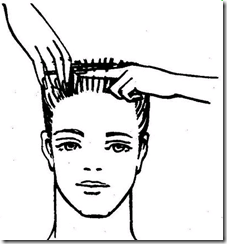
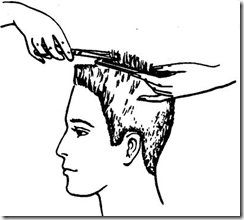
Men's haircut "beaver".

Hair when performing a male haircut "beaver": should keep their shape well.
Tools for male beaver haircuts: straight scissors, comb.
Skill level: self-confidence, mastery of the basic haircut techniques.
This male beaver haircut resembles a square haircut, but at the temples the hair is not strictly perpendicular to the “platform” on the crown,
and the angle between the temples and the "platform" is slightly rounded.
This haircut looks less contrast and therefore more like men. Performing such a haircut is easier, but accuracy and work skills are required.
If you doubt yourself, do a haircut gradually, do not remove your hair immediately to the required length - it will be easier to achieve the desired result.
Performing male beaver haircuts
Beaver haircut begins with the upper occipital area. Hair cut from the center to the temples with vertical partings on the fingers.
The fingers should be perpendicular to the intended area, and the fingertips should touch the head.
The lower occipital area is reduced "to nothing" by a hair clipper.
Then we cut the hair of the parietal zone, that is, we create a “platform”. When starting to form a “site”, one should take into account the client’s wishes regarding the height of the “site”, however, according to the general rule, with a broad face, the hair on the “site” should be left more authentic, and with leaner, shorter.
It is very important when cutting the “platform” to correctly set its level. To do this, we cut the strip from the frontal protrusion in the middle of the parietal zone to the crown. This strand will be a guideline when creating the "site".
The length of the hair at the forehead should be approximately 3-5 cm, and toward the crown the length of the hair will be gradually shortened. At the border with the occipital area (trimmed earlier), the hair is reduced to nothing. In order for the “platform” to have a perfectly even surface, it is necessary to move the comb so that the hair under it continues to remain in a strictly vertical direction. Cutting the hair of the side zones, comb the hair from the bottom up.
The hair of the side zones during cutting should be drawn perpendicular to the “platform”. When cutting the left side, the scissors are arranged with the ends down, and when cutting the right side, with the ends up.
Now we soften the angle between the "platform" and the temples. This can be done with simple scissors with a serrated cut, and thinning shears, but the cut will be straight. Regardless of the haircut, raising the hair on the comb.
To get a good quality haircut, repeat these movements several times on each strand.
We carry out the edging of the haircut over the entire head with the tips of the scissors. For best results, dampen the hair along the trim line.
The upper occipital area of \u200b\u200bhair with a shear with vertical parting on the fingers
We set the level of the “platform” with a vertical parting in the center of the parietal zone
Whiskey with a haircut on a comb
We soften the angle between the "platform" and the temples
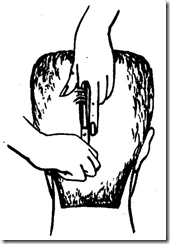
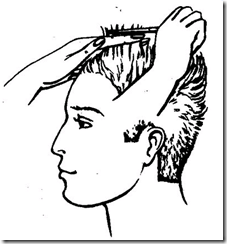
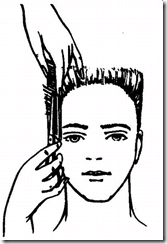

Men's haircut "hedgehog."
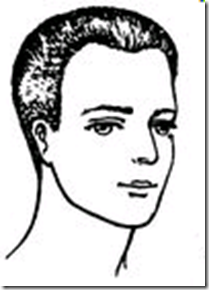
Hair when performing a male haircut "hedgehog": not thin.
Tools for performing male haircut "hedgehog": straight scissors, comb.
Skill level: mastery of the basic haircut techniques.
Haircut "Hedgehog" is similar to a haircut "Beaver", but differs from it in an oval shape.
If you leave the hair shorter, you get a successful interpretation of a short haircut - simple and natural.
Successful options for this male haircut "Hedgehog" allow you to create different kinds hair thinning.
As a rule, such a haircut is performed on hair with a large growth angle.
Performing a male haircut "Hedgehog"
First, cut the hair of the occipital zone to the crown and temporal zone to the temporal protrusions (taking into account possible defects of the head).
If necessary, you can finish cutting the neck 1 cm below the crown.
You can cut the temples and the back of the head with straight scissors on a comb or with the help of a hair clipper.
When cutting the hair of the parietal zone, one must try not to cut the hair on the “platform” below the level of the hair already trimmed at the crown. Therefore, it is better to cut hair with a small margin of length, which is then easily blended. To obtain an oval shape, the edges of the "platform" are slightly rounded.
To make the “Hedgehog” haircut look like a hedgehog, the entire parietal zone can be worked out with thinning scissors.
The “Hedgehog” haircut will be perceived in a completely different way if you work through the ends of your hair with a toothed cut or the pointing method.
A small amount of foam can be used to style the “Hedgehog” hairstyle, while the hair dryer can not be dried.
Squeeze the foam into the palm of your left hand, soak your right fingers in it, insert your fingers into the hair and rise from the roots to the ends.
The upper occipital area by shear with vertical parting on the fingers
Round the edges of the "platform" to obtain an oval shape
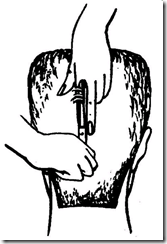

Men's haircut "Voyage".

Hair when performing haircuts "voyage": any.
Tools for haircuts "Voyage": straight scissors, comb, thinning scissors.
Skill level: mastery of the basic haircut techniques.
A characteristic feature of the voyage haircut is the visible clear line that separates the lush volume of the strands of hair of the parietal zone and the strands removed in the lower occipital and temporal-lateral zones. Apparently, due to this characteristic feature, this haircut, as well as haircuts made on the basis of the Voyage, is often called a “hat”.
Performing men's haircut "Voyage"
Draw an arbitrary horizontal parting from one temple to another; on the back of the head, the parting should be lower than at the temples.
Gather the strands above the parting in a bun and secure with a hair clip.
In the lower occipital zone, parallel to the horizontal parting, select a lock of hair and cut the lock on the fingers, leaving a length of 1-1.5 cm.
Cutting the strands must be done, observing the direction of the haircut from the temple to the middle of the occipital zone.
This lock of hair will be the control for the temples and the back of the head.
Next, the method of taking hair “to nothing” by cutting the strands of the temporal zones and lower occipital zone, that is, we make a smooth transition from the edge line of hair growth of the temporal and lower occipital zones to the control strand.
At this stage of the haircut, you can trim the hair.
It is better if the edging line is soft, since the hairstyle “voyage” looks more romantic than strict.
In parallel with the control strand in the upper occipital area, select the next strand, comb it out together with the control strand and shear at the level of the control strand with an extension of 1.5-2 mm.
So in a row cut the entire parietal zone of the head.
Next, we comb out all the strands of the parietal zone according to the hair growth and perform the edging.
We check the clarity of the voyage haircut by combing out the locks at random and eliminating the visible differences in the lengths of adjacent strands.
We make easy thinning of the parietal zone with a thinning razor, highlighting the strands with vertical partings.
We cut the ends of the strands of the parietal zone with thinning scissors, highlighting the strands with vertical partings.
Hair styling should be done in the hairstyle, focusing on a clear line that identifies the parietal zone.
The originality and romance of the haircut “voyage” can be emphasized by highlighting several strands with wax.
Below the parting, select a strand and a shear at a distance of 1-1.5 cm
We carry out a smooth transition from the edge line of hair growth to the control strand
In parallel to the control hair strand, select the next strand and cut the hair with an extension of 1.5-2 mm
Thinning of the parietal hair with a razor
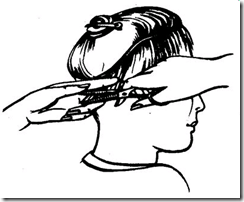
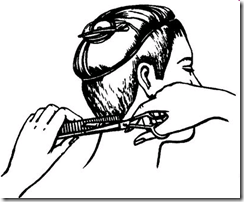
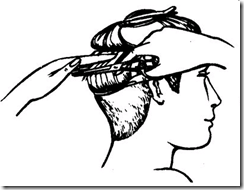

Men's haircut "Favorite."

Hair when performing a haircut “favorite”: any.
Tools for haircuts "favorite": straight scissors, comb, thinning scissors.
Skill level: mastery of the basic haircut techniques.
Another cutting technique, a characteristic feature of which is the visible clear horizontal line,
dividing the lush volume of the parietal zone and short-cut strands by the method of "nullifying" the temporal and lower occipital zones.
Unlike the Voyage haircut, this line will be easier due to the modified haircut technology.
Performing a male haircut “favorite”
Pass the horizontal parting at the top of the ear through the occipital protrusion.
Strands of hair in the lower occipital region by a shear by the reception of "no" information.
First, cut the strands of hair of the lower occipital area, then the strands of the temporal zones.
Arbitrarily in the process of cutting, determine the line of the control strand, the length of the control strand is also determined in the process of cutting.
We divide the hair of the parietal zone with a vertical parting from the middle of the forehead through the crown to the control strand.
We continue cutting hair in the upper occipital area.
In parallel to the control hair strand, select the next hair strand and comb out to the control strand. Cut it at the level of the control strand with an extension of 1-2 mm. So in a row, highlighting the strands with horizontal parting, cutting to a vertical parting, so that each subsequent strand was 1 mm longer than the previous one.
We check the clarity of the haircut on the vertical parting. To do this, comb out the strands to the right and left of it and align the length of the strands: the strands should be equal in length.
We comb out the strands according to the hair growth and carry out the edging of the strands of hair in the parietal zone. We carry out a fringing of a nape and temples. The fringing of the hair should be soft and rounded, as well as the haircut itself “favorite”.
TIPS OF THE MASTER-HAIRDRESSER
A guy during a haircut allows you to change the length of the strands.
Having outlined the control strand and the direction of the haircut, you can begin to correct the length.
If you pull the strands in the direction of the haircut, they will become shorter.
If you pull the strands in the direction opposite to the direction of the haircut, then the subsequent strands will become longer.
The draw angle of the strands will determine the extent of these changes.
All hair from parting to edging on the neck and temples is reduced to nothing
A strand of hair above the parting - at the level of the control strand
Combo haircut
We carry out a fringing of hair on a nape

![]()
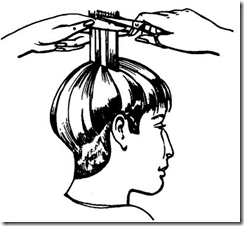
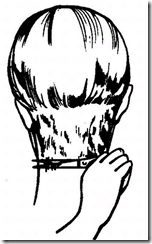
Men's haircut "Brig".
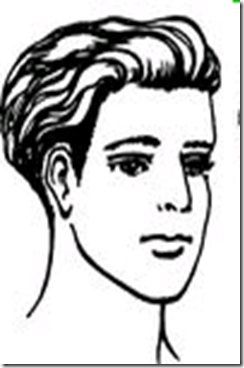
Hair when performing a haircut "brig": any.
Tools for performing a “brig” haircut: straight scissors, comb, thinning scissors.
Skill level: mastery of the basic haircut techniques.
The Brig men's haircut is carried out on the basis of the Voyage haircut and is a haircut, a distinctive feature of which is the lush volume of hair in the parietal zone (step haircut) and strands of hair removed in the lower occipital and temporal zones.
Performing men's brig haircuts
Before you start cutting the “brig”, wash the client’s head and squeeze the hair slightly with a towel.
Draw a horizontal parting at random at the top of the ear. Hair above the parting is stabbed so that the hair does not interfere.
Parallel to the horizontal parting, conducted at random, we select a strand of hair below the parting and cutting, leaving a length of 1-1.5 cm.
We make a haircut, observing the direction of the haircut: from the face to the middle of the occipital area from one side and the other.
Further, by cutting the hair “to nothing”, shearing the entire mass of hair of the lower occipital zone and part of the temporal zones below the horizontal parting. That is, we carry out a smooth transition from the edge line of hair growth to the control strand.
Next, cut hair strands in the upper occipital area.
In parallel to the horizontal parting, we select a strand of hair, comb out this strand to the control strand and cut at the level of the control strand with an extension of 1-2 mm.
At the same time, do not forget to follow the direction of the haircut.
So in a row, highlighting the strands with horizontal partings, cutting the entire mass of hair of the parietal zone to a vertical parting, passing from the middle of the forehead to the middle of the neck.
Parallel to the vertical parting from the middle of the forehead to the crown, we select a strand, comb it perpendicular to the head and cut it arbitrarily.
We will consider this lock of hair a control.
Focusing on its length, cut a strand near the face. We comb the strand perpendicular to the head.
In parallel with this strand, select the next one, comb it out and cut it at the level of the control strand.
So in a row, highlighting the strands with horizontal partings, cutting the entire mass of hair of the parietal zone. In this case, each subsequent strand should be perpendicular to the head.
Next, comb out the strands of hair of the frontal zone on the face and perform the edging.
If the client wears a bang, and the bang is too long, cut a small strand to the desired length, and then, highlighting the strands with vertical partings, eliminate the resulting length difference.
We check the clarity of the “brig” haircut, combing the locks randomly in different directions and eliminating possible differences in lengths of adjacent hair strands with a taper razor.
We cut the ends of the strands of hair of the parietal zone with thinning scissors.
The control strand of hair is below the parting, 1-1.5 cm long
We carry out a smooth transition from the edge line to the control strand of hair
Select a strand of hair above the parting and a haircut at the control level with an extension of 1-2 mm
The control strand of hair for the crown of the head on a vertical parting
Select a strand in the face and cut it off at the level of the newly trimmed
We comb out all the hair on the face and carry out the edging.
We carry out the thinning of the ends of the hair strands with thinning scissors
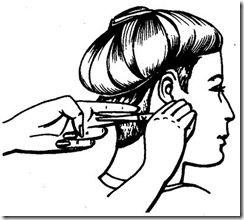



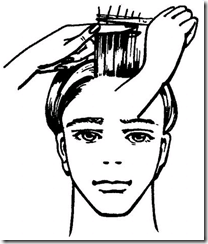

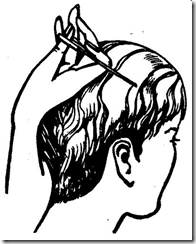
Men's haircut for rare thick hair.
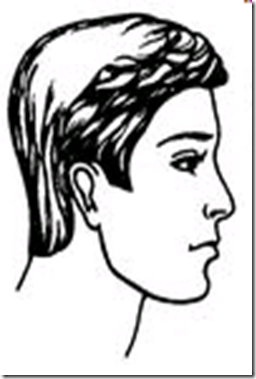
Hair when cutting for rare thick hair: rare, of sufficient thickness.
Tools for cutting thin rare hair: straight scissors, comb, hair dryer, thinning scissors.
Skill level: mastery of the basic haircut techniques.
Haircuts for thin thick hair are performed in such a way as to reduce the volume of hair in the lateral zones and on the back of the head, while maintaining the length of the hair of the upper layer, the softness of the lines of which is achieved by thinning the hair with thinning shears.
This haircut can be done on any hair.
A feature of the technique in cutting for rare thick hair is that the hair must be styled with a hairdryer before cutting.
Performing male haircuts on rare thick hair
Before starting a haircut, wash the client’s head and dry the hair of the parietal zone, lifting it at the roots on the fingers.
In order for the hair to rise at the roots, you will have to carry out with your hands such movements as you would if you worked with a brush for styling hair.
The hair dryer should be directed to the roots of the hair, but casually so as not to burn the scalp.
Improper hair drying will not give the desired effect.
When drying your hair, first hold the hair dryer in your right hand and then in your left.
Select a strand of hair near the face and determine the length of the strand.
Then, using the method, strand after strand, shearing the parietal zone on a comb with thinning scissors.
The lower temporal and occipital zones by shearing with simple scissors with vertical partings with a guy line 90 °, cut at an angle of 45 °.
Now you can trim the hair on the temples and the back of the head.
The hair of the upper temporal zones and the upper occipital region is sheared with thinning shears, taking the hair with wide vertical partings.
Our task is to connect the lower zones of the hair with the parietal.
In the parietal zone we perform thinning of the hair (we cut the hair to half the main length), and if we cut the parietal zone with vertical parting, then now we isolate the hair strands with horizontal parting.
TIPS OF THE MASTER-HAIRDRESSER
Strand by strand on a comb with thinning scissors
Select the strand, raise the hair with a comb, put thinning scissors into the strand below the level of the intended cut and begin to perform frequent movements, moving up the strand and gradually accelerating the rate of closure of the scissors.
Dry the client's hair with a hairdryer at the roots of the fingers
We carry out the edging of the hair of the nape and behind the ears
Select a strand of hair near the face and determine its length
We carry out a combative haircut with thinning scissors
Strands of hair of the lower occipital area are cut off at an angle of 45 °
We carry out thinning of the hair of the crown at half length

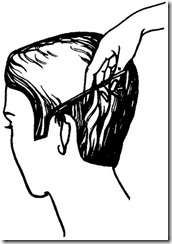

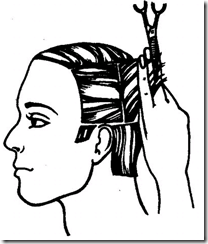
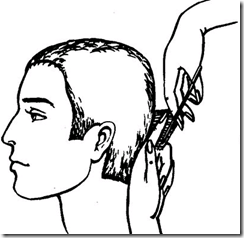
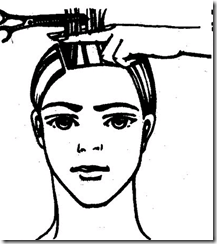
Men's haircut "Sagittarius".
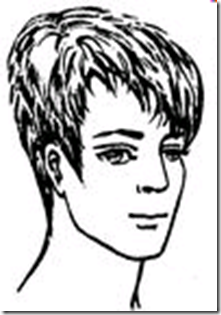
Hair when performing a haircut "Sagittarius": any.
Tools for haircuts "Sagittarius": straight scissors, thinning shears.
Level of skill: self-confidence, mastery of basic techniques.
A characteristic feature of the men's haircut "Sagittarius" is the presence of a high side parting with an elongated bang.
The temple is open, the fringing of the temple "corner".
It is good to do the styling of the “Sagittarius” haircut with wax, creating locks, or comb the hair with a comb after drying.
It is recommended to give hair cutting volume and highlights to highlight hair on a hat.
Performing a male haircut "Sagittarius"
We begin haircut "Sagittarius" with the right temporal-lateral zone.
In parallel to the edge line of hair growth, select a strand with a horizontal parting, comb it along the hair growth and perform a “corner” edging.
In parallel to this strand, select the next one, comb it to the previous one and cut it at the previous level with a guy 45 °. So in a row, highlighting locks of hair with horizontal partings, cutting the entire temporal zone on the right side.
Then, similarly to the shear, the temporal zone on the left side.
Parallel to the edge line of hair growth in the temporal zone on the right side, select a strand with a vertical parting, comb out the strand on the face and perform a fringing.
With a vertical parting, we select the cut hair at the temple near the occipital area, comb the unclipped hair from the occipital area to it, pull it a little to the side of the face and cut it off at the level of the already trimmed hair.
So the method lock by lock, highlighting the strands with vertical parting, cutting to the middle of the occipital zone all the hair of the temporal-lateral zone and the upper occipital zone.
In the process of cutting, pay attention to the increase in the length of the strands to the middle of the occipital zone. Similarly, cut all the strands on the left side.
Next, in the lower occipital zone, we carry out a preliminary edging with a bracket and taking all hair strands on the fingers with a hair removal technique.
That is, parallel to the boundary line of hair growth in the lower occipital zone on the right side, select a strand with a vertical parting, comb it together with part of the strand of the upper occipital area and cut, focusing on the length of the strands of the upper occipital area and the length of the fringing strands.
In parallel with this strand, select the next one, comb out together with the previous one and cut it at the previous level at an angle of 90 °.
So in a row, highlighting the strands with vertical partings, cutting all the hair of the lower occipital zone with a slight pull to the face.
We carry out the edging of the hair behind the ear, repeating the hairline.
Next, highlighting the strands of hair with diagonal partings, we perform a test haircut of the strands of the occipital zone on the right side of the vertical parting.
At the same time, the direction of the haircut is from the ear to the crown.
Similarly, cut hair strands to the left of the parting.
We make the final edging in the lower occipital area.
We perform hair cutting in the parietal zone.
To do this, parallel to the lateral parting, separating the parietal and temporal zones, in the temporal zone, select a strand, comb it perpendicular to the head and trim.
Parallel to this lock in the parietal zone, select a lock and comb it to the previous lock, cutting at its level, while the lock of the temporal zone is perpendicular to the head. So in a row, highlighting the strands with vertical partings and combing them tangentially to the head, cutting all the hair of the parietal zone.
Swift, combing out all the strands of the parietal zone, first to the right, and then to the left.
We carry out a fringing of hair of a parietal zone.
To do this, comb out all the strands of the parietal zone on the face and carry out the “corner” edging, connecting the strands of the temporal zones and the parietal zone.
We cut the ends of the hair with thinning scissors.
At the temple we carry out the hair trim “corner”
We carry out a haircut of the temples, focusing on the control strand, with a guy 45 °
Control hair strand for the occipital area at the temple
We carry out a preliminary fringing of hair with a bracket on the fingers
We carry out a test haircut of hair with diagonal partings
We perform hair cutting of the parietal zone with vertical partings
We carry out a fringing of hair of a parietal zone "corner"
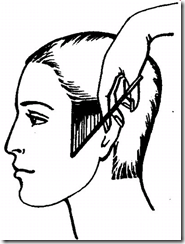

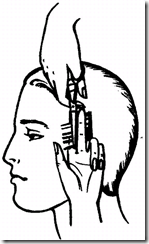
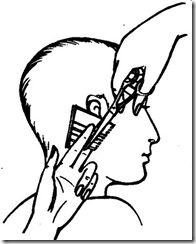
![]()
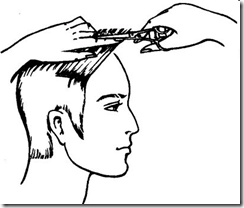
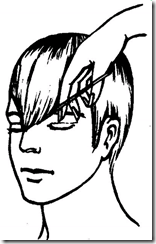
Men's haircut "Curl".
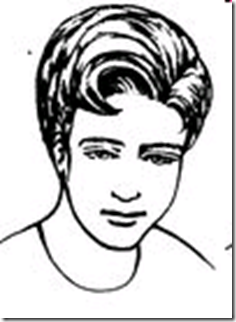
Hair when performing a haircut "curl": any.
Tools for haircuts "curl": straight scissors, comb, thinning scissors.
The “curl” haircut is characterized by the absence of clear lines, soft transitions to the occipital area and lateral strands, turning into elegant strands that go down to the face.
Above the forehead, the hair of the frontal zone forms a slightly outlined vertical curl.
The technique of thinning for the parietal zone can be used in other haircuts. On the back of the head, the corner of the “cap” can be made soft or sharp.
Thin tanks will look good.
Performing a men's haircut "curl"
We carry out a fringing of hair on a nape. It is better if the edging is sharp.
Haircut "curl" youth, and preference in its implementation is given to all sorts of new directions in the haircut.
The temple can be sharp and long. Thin tanks will look good.
We select a horizontal parting, from ear to ear, at an angle with the apex at the height of the cervical vertebra and cut very short the hair of the lower occipital area with scissors above the comb.
Separate the hair parting from the middle of the occipital zone to the temple, observing the angle at the back of the head.
Cut hair with vertical partings at an angle of 45 °, focusing on the trimmed lower zone.
With a parting parallel to the edge of the trimmed area, we select a strand of hair from one temple to another and cut to the desired length.
At the temples, the hair should at least cover the earlobes. At the back of the head we observe the angle.
The hair of the crown is combed by growth and we trim the hair at the level of the freshly trimmed hair.
Thinning shears cut the hair of the parietal zone. Select the control strand in the face, set the length and move to the back of the head.
Trim the parietal zone by strand by strand method.
We perform graduation of the hair on the crown, while we isolate the strands perpendicular to the fact that just selected.
Graduation of hair is done at an angle, while the angle should point towards the face.
At the back of the head, partings should go out from a point on the crown, and the angle should be indicated away from the crown.
The hair below the hair parting is very short over the comb
Hair cutting of the parietal zone is performed with horizontal partings with thinning scissors
We set the length of the control strand of hair above the parting
We perform hair thinning on the back of the head
Filtration of hair on the crown is done by parting in several places
We carry out fringing of a bangs by a sliding cut
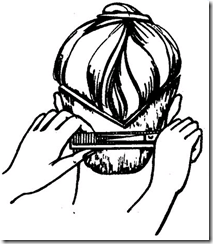
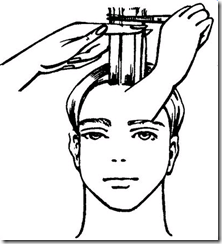


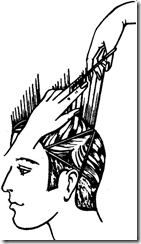

Asymmetric male haircut with parting.

Hair when performing an asymmetric haircut: medium density and medium softness.
Tools for performing asymmetric haircuts: straight scissors, comb, razor.
Skill Level: Ability to work with a razor.
An asymmetric haircut with parting is recommended for young and middle-aged men with any hair structure, except for thin ones.
Asymmetric haircuts are performed on clean, damp hair, mainly with a razor.
You will need some work skills.
The technique of asymmetric haircuts is that under the mass of hair of the parietal zone on the opposite side of the parting with a razor, the basis for the volume of hair is created.
Asymmetric haircut with parting
With parallel parting we separate the parietal zone of the hair from the temporal zones.
Asymmetric haircut begin at the temples.
With vertical partings parallel to the hairline, we separate the strands on the right and left temples and with a guy on the face we cut off with a razor.
These locks of hair will be the control.
The subsequent strands were sheared to the middle of the nape by strand by strand method with a guy to the face. Using the same method, we also filter the lower part of the occipital area.
To do this, first on the right and then on the left in the lower occipital area near the temple, select a strand of hair with a vertical parting next to the edging line and cut it with a razor, while milling along the entire length.
So shear the entire lower zone to the central vertical parting on one side and then on the other.
We carry out edging of temples and a nape with straight scissors with a gear cut.
Along the line of natural parting, we select a strand of hair 2 cm wide and a shear with scissors in the shape of a “fringe” 3-4 cm long.
Using a razor, brush the hair first to the temple, and then from the crown of the head to remove a sharp transition in length, focusing on the previously trimmed hair of the temporal zone on the opposite side of the cut parting and the left length at the parting.
We perform a connecting haircut of the crown to the sagittal parting. We cut with straight scissors with a serrated cut.
Continuing the unifying haircut in a circle, to a cut parting.
On parting, on the back of the head, brush off the hair with a razor.
To do this, select 2-3 horizontal partings with a thickness of 1.5-2 cm.
Hair styling with a hairdryer is done without parting.
Hair should be laid asymmetrically on the forehead.
Select the strands of hair at the temples, comb it on the face and cut it with a razor
We perform the unification haircut of the opposite temple
A strand of hair 2 cm wide by a shear in the form of a "fringe" 3-4 cm long with a sliding cut
We brush the hair to the temple with a sliding cut
Brush the hair to the crown of the head
On the back of the head, brush the hair with a razor.
![]()



![]()
Men's haircut with unique technology.

Hair when cutting: soft, not liquid.
Tools for cutting: straight scissors, comb, thinning scissors.
Skill Level: Excellent knowledge of haircuts.
When performing this hairstyle, special attention should be paid to the haircut technique. Thanks to a professionally performed haircut (the appearance of the hairstyle has a triangular and asymmetric shape), the hair lies freely, revitalizing the face and giving it a peculiarity.
The hair on the back of the head is quite short, but retains its volume.
Performing men's hair cutting using unique technology
Wash the client's hair before starting a haircut. Based on the point in the center of the crown, divide the hair into six sections, which are six sharp triangles.
These sections of hair are distributed as follows: one in the front of the head, two on the sides and three on the back of the head.
For convenience, the hair of these areas can be stabbed. If the hair is wet enough, it is enough to comb it properly.
We begin the haircut in the center of the nape in the direction from the bottom up to the distribution point of the strands.
To do this, select a strand 1-1.5 cm wide along the edge of hair growth on the back of the head and cut it off. The length of this lock of hair is not more than 2 cm.
Above the trimmed strand, select the following, comb out the strands of hair together and cut it off. Extending strands 60 °, cutting the entire area by strand by strand method. You should cut it by holding a lock of hair between your fingers and pulling it tightly.
We continue cutting hair at the back of the head according to the same principle.
In the same way, cut sections of hair over the ears.
We align the hair strands according to the previous ones, holding them perpendicular to the scalp.
Then shear the connecting strand between the side and upper hair. This lock of hair will be the control.
Thus, all the hair in the upper part of the head will be combed in successive strands perpendicular to the face.
The effect of such a haircut is to automatically gain a win in length.
When cutting, it is necessary to strive at the same time to ensure that as you move to the front of the head, the hair length increases.
Then comb the hair in the upper part of the head as it should lie in the hairstyle, compare it with the side hair (from the face to the back of the head).
Next, determine the length of the tanks.
Having outlined the contour of the ear, we lighten the mass of hair in this area with the help of thinning scissors.
Then we evenly lighten the bottom of the head and check the front strand of hair, combing the hair on the face.
Its contour should fit in a line along the oblique to correspond to the asymmetric length of the hair in the upper part of the head.
The hairs on the sides are well-dried, raising the hair, then we continue styling using a brush and a hair dryer and striving to maintain maximum hair volume.
It is necessary to observe a clearly marked change in the length of the hair in the profile and in the face.
It should be emphasized that this triangular and asymmetric shape of the hairstyle is obtained solely due to the haircut.
Divide hair into six sections based on the center of the crown
Control strand of hair for the occipital zone at the hairline
We cut the back of the head with the method strand by strand with a guy 60 °
All hair of the parietal zone is successively equated with the control strand
The control strand of hair for the crown on the parting
Facilitate the mass of hair in the temporal zones
We carry out an asymmetric fringing of a bang "corner"
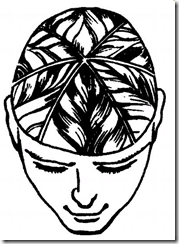

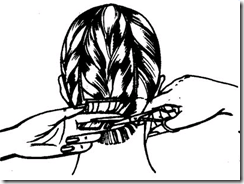

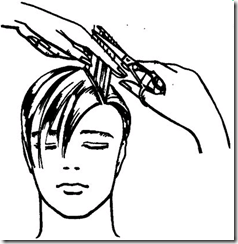
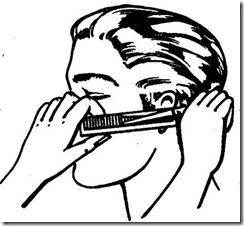

Men's sports haircut .
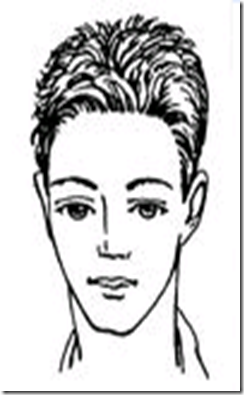
Hair when doing sports haircuts: not very thin and rare.
Tools for doing sports haircuts: straight scissors, comb, thinning scissors.
Mastery Level: Beginner.
The styling of this men's sports haircut can vary widely depending on the style and situation.
Undoubtedly, there is nothing more convenient than a short haircut, but the requirements for the quality of the hairdresser's work in this case will be increased. Here's a haircut option for a business or sporty man who strives for accuracy and restraint, rather than romanticism.
Remember, any haircut requires maximum accuracy from the master, and a short haircut - especially.
Performing a men's sports haircut
We begin cutting hair from the back of the head. In the center of the occipital zone, with vertical parting, select a strand of hair 1 cm wide, comb the strand perpendicular to the head and cut it at an angle of 90 °. The length of the hair strand is approximately 3 cm.
This lock of hair will be the control.
We move from the center to the temples, focus on the control strand.
So we do the haircut of the entire upper occipital zone.
We turn to haircut temples.
On the edge line of hair growth with a vertical parting, we determine the strand, pull it perpendicular to the head and cut it at a 90 ° angle, while the fingers are firmly pressed to the head, and move to the back of the head.
Then we select a strand of hair in the center of the parietal zone with vertical partings, comb the strand perpendicular to the head and cut to the length we need (from 3 cm and longer). Delay during cutting 90 °. This lock of hair will be the control. With its help, we will determine the length of the strands on the crown, which we will select not with vertical, but with horizontal partings.
In parallel to the edge line of hair growth in the face, we select a strand, comb it perpendicular to the head and shear, focusing on the control strand.
So by horizontal parting we divide and cut the entire parietal zone. We connect the parietal and temporal zones, cut off the corner.
We make the edging of the haircut on the back of the head, behind the ears and on the temples.
On the back of the head, using the shading technique, we make a smooth transition from short hair along the edge of hair growth to the already trimmed upper occipital area. We use the same technique at the temples.
We remove all possible defects with the help of thinning scissors.
We cut the bangs with straight scissors with a sliding cut. Filtration with a sliding slice must be done so that the hair breaks into strands themselves, and at the same time the bangs will look very natural.
We fix the hair with gel and put it in the right direction (we lift it at the roots or smooth it).
A control strand of hair in the center of the occipital zone 1 cm wide
We cut the temples with vertical partings.
We carry out the edging of the temples
In the center of the parietal zone, we select a strand of hair
Determine the length of the control strand of hair for the crown
We cut the bangs with straight scissors with a sliding cut
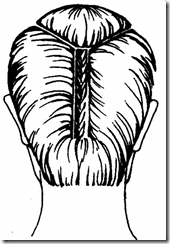
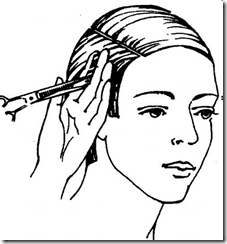
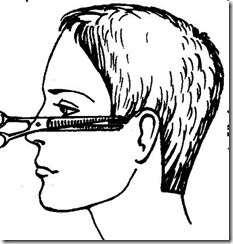
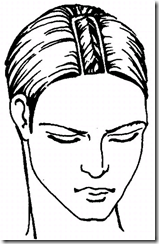
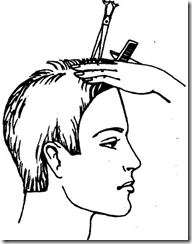

Hair cutting “cloves”.

Hair when cutting “cloves”: curly or slightly curly.
Tools for cutting “cloves”: straight scissors.
Skill level: mastering the main types of slices.
Hair cutting with “cloves” is suitable, first of all, for those with curly hair.
Hair cutting with “cloves” looks rather short, and hair cutting technique with “teeth” allows the hair to look thicker.
The “cloves” cut creates soft contours of the cuts.
The haircut looks very natural and neat at the same time.
Hair cutting “cloves”
We begin the haircut with the upper occipital area of \u200b\u200bthe hair. In the center, we select a strand of hair, pull the strand perpendicular to the head and cut it with “cloves” to give the hair a softer texture.
Focusing on the hair that has just been trimmed, with the vertical parting of the hair cut, first the upper zone of the hair, and then the lower occipital zone.
During the haircut, we move from the center to the temples.
Remember that with an increase in the draw angle to either side, the strands will be shortened or lengthened.
In the center of the parietal zone, we highlight a strand of hair with vertical partings, outline its length, focusing on the trimmed nape. We perform a haircut on the fingers. This lock of hair will be the control.
The cut line runs parallel to the head, the reference point for the length of the hair on the back of the head.
We cut the temples, focusing on the crown, highlighting the hair strands with vertical partings.
We complete the haircut by fringing on the back of the head, temples, we draw the edge line of the bangs, giving the hair the effect of an “overgrown haircut”.
It is best to use wax to style your haircut.
In the center of the occipital zone, select a strand of hair and perform a haircut with “cloves”
The control strand of hair in the center of the parietal zone
We cut the temples, focusing on the crown
We give the hair the effect of “overgrown haircut”

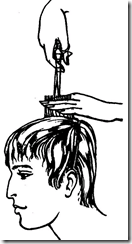

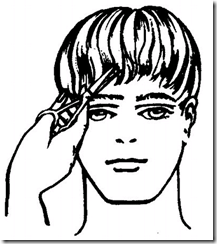
Men's haircut graduated caret.
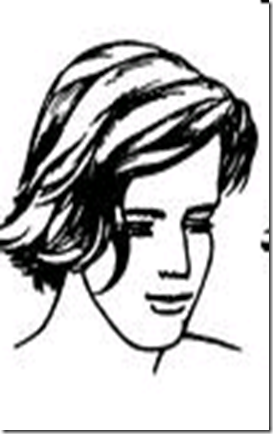
Hair when performing a man's haircut graduated caret: soft or medium soft.
Tools for haircuts graduated caret: straight scissors.
Mastery Level: Diligent beginner.
Graduated caret haircuts are liked by men with slightly curly hair and those who like to take care of themselves and devote enough time to their appearance.
Graduated caret can be worn with or without parting.
Often, a caret cut is performed without graduation.
You will also be able to perform such a caret, for this it will be enough to make only the first part of the haircut (before graduation).
The technique of performing male haircuts graduated caret
A man’s haircut is a graduated caret for long enough hair, and a haircut is carried out only on wet hair.
With a horizontal parting, we select a strand of hair on the back of the head along the edge of growth.
All hair above the selected strand for convenience is stabbed.
Determine the length of the hair strand.
It should be remembered that after the hair has dried, the length of the hair will be reduced. Therefore, the first strand should be slightly longer than the desired length.
This lock of hair will be the control at the first stage of cutting.
Also, with a horizontal parting, we select a lock of hair above the control lock, comb out with it and cut off on the fingers, focusing on the control lock, while the hair extension should be zero.
If the caret should be without graduation, each strand during cutting should be 1.5-2 mm longer than the previous one.
During the haircut, we gradually turn to the temples.
That is, when you cut a horizontal parting at the top of the ear during cutting, then this parting will be already over the entire head from ear to ear.
For graduation, select a strand of hair on the top of the head. This strand at the base should have a rhombus with vertices pointing towards the middle of the neck and face, to the ears. Straight hair strand 90 °.
Determine the length of the strand. The strand should be at least 10 cm.
All other hair is consistently pulled to the control strand of hair and cut.
We perform graduation as follows. In parallel to each of the partings in the occipital area, we select a strand, comb it to the control strand and cut it off at its level.
All this is done until we cut off all the hair longer than the control strand.
It is more convenient to perform graduation from the back of the head.
We comb out all the hair on the face and perform an oval edging. You can trim the hair with a slice or cloves.
We finish the whole haircut with a sliding slice all over the head from the roots of the hair to the ends.
TIPS OF THE MASTER-HAIRDRESSER
If you are cutting a caret without graduation, then at the end of the haircut, work out all the hair using the point method. Perform all the same movements that you just did, only the scissors need to be held parallel to the hair. Poynting is performed on dry hair.
Swift control strand, the length of the strand determines the length of the haircut
Occipital hair strands are highlighted with horizontal partings and cut off at the level of the control strand
When we rise to the temples, parting we do from ear to ear
For graduation on the crown, select a strand of hair, at the base of which is a rhombus
We carry out a fringing of hair in the face in the form of an arc
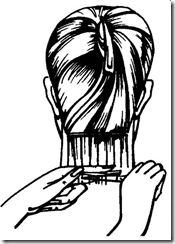
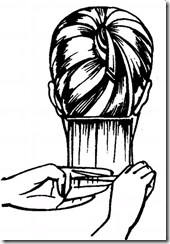
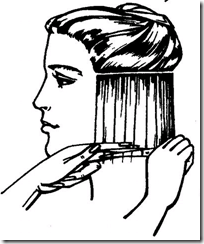
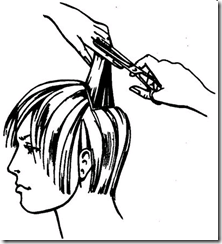
![]()
Men's haircut creative "hat".

Hair when performing a male haircut creative "hat": thick.
Creative haircut tools for cutting: straight scissors.
Mastery Level: Excellent knowledge of the basic haircut techniques.
Men's haircut creative "hat" is a very modern youth haircut.
A creative haircut haircut is easy to fit, keeps well on any hair and maintains its shape for a long time.
For haircuts creative "hat" there are many options for hair coloring and hair styling.
Such a haircut will emphasize the masculinity of a romantic man and adorn the courageous.
Technique of performing male haircuts creative "hat"
We start the creative “hat” haircut with a hair trim. Separate the temporal area of \u200b\u200bthe hair parting from the parietal zone and perform a straight hair trim on the temple.
As it should, work out the edging of the hair behind the ear. Hair should extend along the base of the ear.
Similarly, we trim the hair on the other hand.
All hair is combed back and we carry out a fringing of hair on the back of the head.
The rim of the hair should be straight, and the transition from the rim behind the ears is almost vertical.
A straight parting from ear to ear above the earlobes separates the hair of the parietal zone.
All the hair is parted below the hair cut, highlighting vertical strands, with a hair extension of 90 °. Cut hair at an angle of 45 °.
We cut this zone from the middle of the back of the head, first to one, then to the other side.
We comb out all the hair by height and outline the “cap” line with straight sections.
At the top of the head in the parietal zone (on the sagittal parting), we select a wide strand of hair, determine the length and cut the strand of hair with teeth.
We cut all the hair of the crown using the method strand by strand, moving from the back of the head.
The entire parietal zone was sheared to bangs, highlighting the hair with wide locks.
We cut the bangs with straight sections at an angle.
To do this, divide the entire bang into several horizontal locks of hair and cut them at different angles.
We work out all the hair of the parietal zone, starting with the bangs, by the method of pointing on dry hair.
Apply styling foam to wet hair and blow dry with a hairdryer with a simple comb or comb.
If you perform styling with brushing, then the appearance of the client will be softer and not bright.
We carry out hair edging on the temples with straight scissors
We carry out a fringing of hair on a nape in a straight line
The hair zone below the parting of the hair cut, highlighting the hair with vertical locks
The parietal area is sheared from the nape of the face to the bangs
Set the line of the “cap” over the entire head, starting from the back of the head
All hair of the parietal zone, starting from the bangs, is worked out by pointing

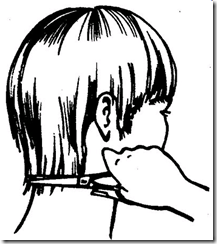
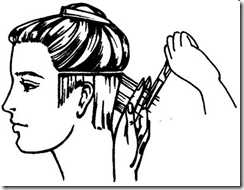
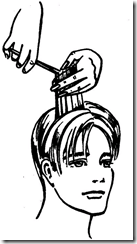
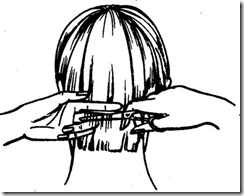

Men's haircut double caret.
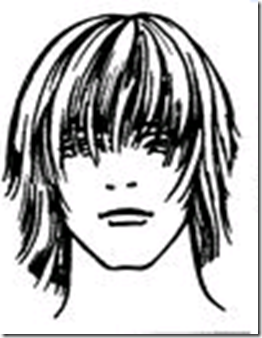
Hair when performing a haircut double caret: any.
Double-haircut cutting tools: straight scissors, thinning shears.
Skill level: mastery of the basic haircut techniques.
Double care this bright creative men's haircut that will require your accuracy and skill.
Although the haircut is called a “bob”, the method of performing this haircut is different from that described previously.
A double cut men's haircut is suitable for men who like to style their hair in locks and are happy to wear long bangs.
The technique of performing male haircuts double caret
In a zigzag part, we separate the temporal zones and the occipital zone of the hair.
This parting should begin in the face on one side and end on the other side (that is, from one temple to the other). Parting should extend above the ears.
We stab the hair above the parting so that the hair does not interfere during the haircut.
Below the parting at the temple, select a strand of hair and determine the length of the upper part of the haircut (approximately to the middle of the ear).
Now, highlighting the strands with vertical partings, we will graduate the hair of the lower part of the haircut, moving from the face to the back of the head.
We comb out each selected strand up and cut it off at the level of the previously trimmed edging. So we do a haircut, first on one side of the head, then on the other.
We carry out a trim of a haircut of the caret all over the head. Trim hair on fingers with a small stretch of hair on himself. Then we edge the edge of the edging with a toothed cut or with thinning scissors (if the hair is very thick).
In the center of the parietal zone, a strand of hair is distinguished.
We twist the strand into a tourniquet and cut off at the required level of about 10 cm.
Separate the strands of hair from the central point on the parietal zone and cut the strands, moving clockwise. Cut hair parallel to the head.
The guideline for the length will be the hair trimmed before.
If the hair is thick enough, work through the entire parietal zone, backing 2-3 cm from the ends.
We carry out a fringing of locks of hair at the face with straight scissors by a sliding cut. We begin the edging from the middle of the bangs down, first from one side, then from the other side.
Along the entire length of the hair we pass with a sliding cut with straight scissors.
It is possible to style a double haircut completely differently depending on the wishes of the client.
Below the parting, select a strand of hair and determine the length of the upper part of the haircut
Lower hair graduation
Double-edged haircuts are trimmed all over the head
In the center of the parietal zone, we select a strand, twist it into a tourniquet and cut it off
We perform a haircut of the crown in a circle, focusing on the hair trimmed earlier
Front hair symmetry control with a double bob in front
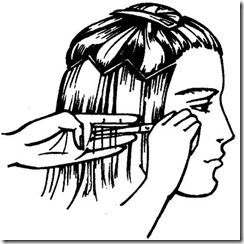
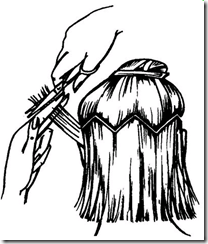
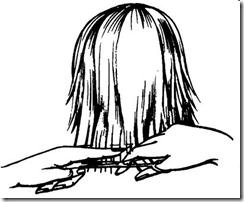
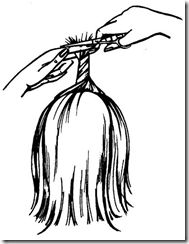
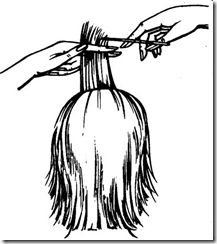
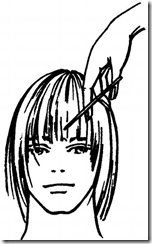
The modern version of the male half-box haircut.
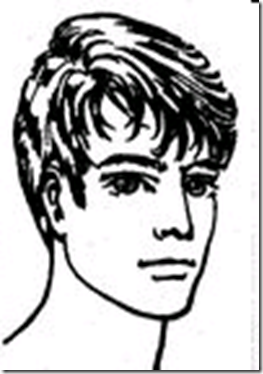
Hair when performing a modern version of a male haircut half-box: any.
Tools for the modern version of the male half-box haircut: straight scissors, thinning scissors, comb, hair clipper.
Skill level: mastery of the basic haircut techniques.
The modern version of the male half-box haircut is suitable for all occasions -
both for special occasions, or business negotiations, as well as for sports.
When you learn how to make classic haircut options, try this new haircut technique.
It has several new tricks - having mastered them, you can diversify the implementation of other haircuts
Technique of the modern version of the male half-box haircut
We begin the haircut by completing the edging of the hair behind the ears, and then the edging of the hair on the back of the head.
Using a hair clipper, remove the fluff on the back of the head and modify the edging line.
This method of trimming hair is very convenient, as it allows even a layman to complete the trimming quickly and without errors.
On the back of the head with thinning scissors we perform hair cutting by taking “no to hair” removal.
Especially frequent movements with scissors are performed along the fringing line.
The thinning itself is performed many times first at the ends of the hair, and each time we make a haircut, introducing a comb into the hair deeper.
Using vertical parting at a 30-45 ° angle, cut the hair of the upper right and upper left temporal zones by strand by strand.
In this case, we focus on the hair of the lower temporal zones.
Hair cutting of the upper occipital zone is performed from the temples to the nape of the fingers.
We select the strands with horizontal partings, pull the hair at an angle of 90 ° and cut it, focusing on the freshly trimmed hair.
In the upper occipital area, we check with horizontal partings. We remove all inaccuracies with a clove of teeth.
Checking with perpendicular parting is always the best option, and for short haircuts - especially since it is difficult to grab hair with thin strands.
In the parietal area between four fingers, hold three strands of hair, lift the strands vertically and arbitrarily cut in the form of a "Christmas tree".
Strand by strand, thin the parietal zone at the roots with thinning scissors.
Fill the hair on the bangs with “cloves”.
We begin the haircut of the half-box by performing a hair trim around the head
With the help of a hair clipper, we finish the edging
The lower occipital area is reduced to "no."
Whiskey shear with vertical partings from the face, cut at an angle of 30-45 °
Control strand of hair for the upper occipital area at the temple
On the crown, we hold the strands between the fingers and the swift in the form of a "Christmas tree"
We make a thinning haircut semi-box on a comb
We carry out the fringing of hair on the bangs with “cloves”
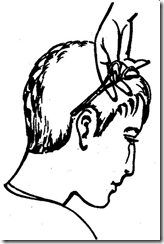
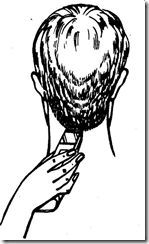

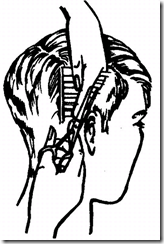
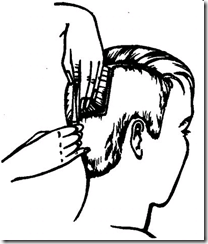
![]()
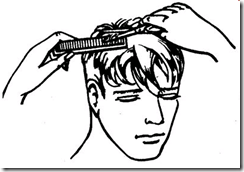

Haircut beard and mustache.
![]()
Beards
Beard haircut.
Face beard correction.
Mustache and whiskers
A beard and mustache can not only decorate faces, but also hide existing imperfections, such as a small or beveled chin,
too full cheeks, a long or very wide nose, a large distance between the nose and upper lip, full lips, etc.
The hair of the beard and mustache is coarser than the hair of the head, sometimes the hair of the beard and mustache grow unevenly and can even have different shades of color.
The thickness of the hair of the mustache and beard also varies.
All this must be taken into account when choosing their style, because it is impossible, for example, to wear a mustache if hair grows very rarely above the upper lip.
Beards
The choice of the shape of a beard is purely individual. The beard can be oval, wedge-shaped, wide, narrow, have the form of a trapezoid, shoulder blade, "frill".
When cutting a beard, it is always necessary to take into account the color of the hair: for example, with dark hair and fair skin, you should not make the beard shape very voluminous, and it is better to shave the hair on the cheeks so that the hair does not stand out too sharply on the face (caret, "horseshoe", skipper).
With light and red hair, the beard can be wide, since the beard is not so sharply distinguished from the background of the face.
The growth of a person also affects the choice of the shape and size of the beard. So, with short stature, the beard should be small in size (frill, square, goatee).
With medium height, the choice of the style of the beard and mustache is unlimited, but men of tall stature should wear a large, broad beard, which significantly increases the face and improves the proportions of the figure. When choosing a mustache style, growth should also be considered.
The hair on the cheeks can be shaved, or you can leave it.
If the hair on the cheeks does not shave, then the beard haircut should begin with the design of the base - removing the hair on the cheeks and neck.
Moreover, the longer the beard, the less hair should be removed on the cheeks and on the neck.
Before starting a haircut, the beard must be combed well by placing the palm of the left hand under the beard.
Then cut the hair from the sides, while holding the scissors with the ends up. Reducing the beard cone to nothing, it is necessary to constantly monitor that its sharp end is located exactly in the center of the chin.
After that, the hair is shaded over the jaw near the ears, and then the entire surface of the beard is polished.
If the cheeks should be shaved, then work begins with the shaving of the cheeks and neck to the line of the beard.
Then the mustache is trimmed, the hair is removed under the lower lip and the beard begins to be styled on the comb.
The oblique edges of the beard should be very finely shaded.
The simplest, most artless form of the beard is worn, as a rule, by people engaged in purely male work and showing that they have no time to engage in themselves.
An English (skipper) beard is most often preferred by men related to the sea and wanting to emphasize this.
Goatee is usually associated with the image of a courageous intellectual. Cheek hair is removed very shortly or even shaved. After this, the transition is worked out, and it is very important that the side lines of the beard are strictly symmetrical.
Oval beard. First, they cut the hair on the neck, on the cheeks, and then (standing to the right of the client) cut the right side of the beard, smoothly reducing the hair “to nothing” to the temples. Then, going to the left side, the left part of the beard is similarly shaped. After that, an oval beard contour is formed and polished.
A long beard of a square is cut like a Russian beard. The hair on the cheeks closer to the cheekbones is removed and extinguished, the mustache is separated from the beard by a sharp line. When cutting short beard caret requires great care.
On the right and left sides, the hair is removed in an oblique line from the earlobes to the mustache, on the neck and cheekbones - shaved. Then all the faces are carefully extinguished and polished.
Russian beard. Getting to the haircut, first cut the base of the beard. Cheeks do not shave, the ends of the hair usually remain in their natural form. The line of hair on the cheeks is not interrupted and is integral with the hair of the beard. The mustache is separated from the beard, for this, at the corners of the mouth and lower lip, the hair is trimmed with the ends of the scissors. Goatee (hair under the lower lip) should also be removed.
After that, having carefully combed the beard, proceed to the final design of the beard (depending on the intended shape). The beard can be trimmed laterally, left longer or shorter.
Cone-shaped beard. A cone-shaped beard is characterized by a pointed end and straight lines of the cone. In no case should they be curved or broken. The hair on the cheeks can be shaved, or you can leave it.
FACE CORRECTION BEARD
The round face is adjusted by the splendor of the hair in the parietal zone and the beard from the temple to the temple of elongated shape (for example, "trapezoid"). The mustache should be medium in size with the ends down.
A triangular face, tapered down, requires a rounded beard in the shape of a horseshoe or square to expand the lower part of the face and give the chin a more massive look.
The elongated face is adjusted by a wide rounded beard (for example, oval in the shape of a horseshoe, trapezoid). It is not recommended to wear a goatee or cone-shaped beard, as such beards visually lengthen the face even more.
The trapezoidal face is corrected by a beard, which will visually narrow it in the lower jaw.
To do this, a beard "frill", skipper, like a square.
Beard haircut
Comb the beard, holding the beard with his left hand
Haircut from the sides of the beard is performed holding the hair up
Shading a whiskers on a comb
You can trim whiskers with a hair clipper
types and forms of beards
Beard Shovel Sphenoid Beard
Skipper Beard Beard "Jabot"
Russian narrow beard (can be short, medium, full) Russian wide beard (most often has the shape of a scapula)
French sharp beard french full beard
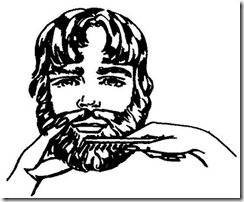
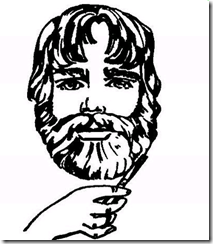

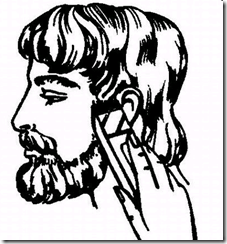
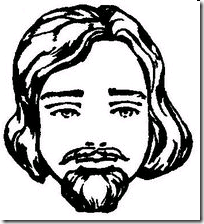
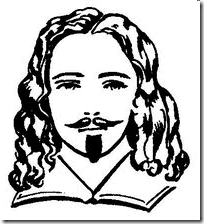
Wedge-shaped
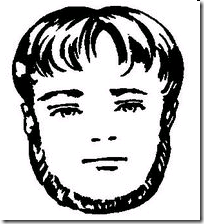
SKIPERSKAYA
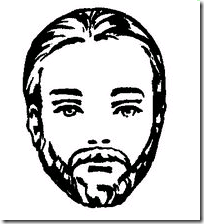
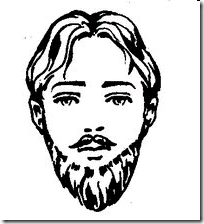
Russian narrow

Russian shovel

French narrow

French full
Haircut mustache and whiskers.
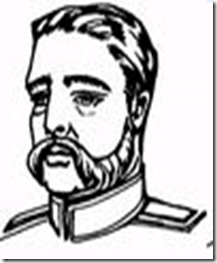
Mustache and whiskers
Psychologists say that by the shape of a mustache you can determine the nature of a person and find out if he imitates idols, whether he follows fashionable trends or adheres to his views, while maintaining his personality. For example, a walrus mustache gives out a lover of zucchini and fun companies.
The shape of the mustache is determined by the features of the face and primarily the size of the nose and lips.
Mustache can be shortened, short, long, narrow, lush, curly.
Long mustaches (such mustaches are also called Ukrainian) have narrow ends, which are formed by a razor, by the method of thinning.
If the mustache is too lush, you can strip the hair layer with thinning scissors; To reduce the length of the mustache, the mustache should be trimmed by combing the comb from the ends to the roots.
A short, or English, mustache is cut against the growth of hair, and after that the mustache is shaped.
When cutting a mustache, the scissors should not be in a very sloping position, otherwise you can injure the skin over the upper lip.
Curly mustache. First, the mustache itself is trimmed, and then a notch in the middle of the mustache is shaved with the ends of the razor. In order to get a curly shape, the edges of the mustache are trimmed.
Whiskers should always have a clear, definite shape. To prevent whiskers from entering those areas of the skin where there is no hair, whiskers are carefully edged on the sides and bottom edge.
The hair of the temples and whiskers should be the same length and make up a single line.
Shearing of whiskers is done with scissors and a hair clipper.
Mustache, beard, stylish whiskers always attract attention and give the man an impressive look.
When choosing a model of a mustache, beard, whiskers, one must take into account the fashionable direction, but always in accordance with the individuality of a person.
TIPS OF THE MASTER-HAIRDRESSER
Mustache and beard must be very well-groomed, otherwise they get a sloppy appearance and do not decorate their master.
types and shapes of mustache
Ukrainian full mustache 1
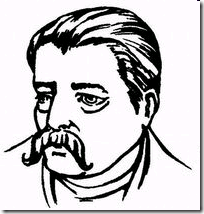
Figured Mustache 2

Half Round Full Mustache 3
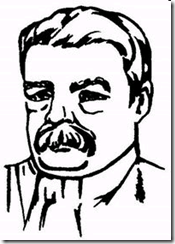
Volumetric mustache emphasizes efficiency, position, confidence 4

Such a mustache can belong to a person of “bohemia”, romance 5
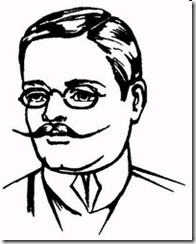
Elegant look of “socialite” successfully complemented by a mustache 6

This is a mustache of a womanizer, smoothie, a lover of riding and women 7

Elegant fluffy mustache characterizes their owner as a thinking person, able to make independent decisions 8
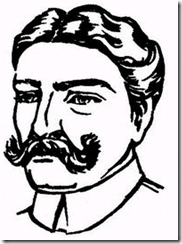
Mustache of an intelligent business man, accurate and accurate in the implementation of his decisions 9
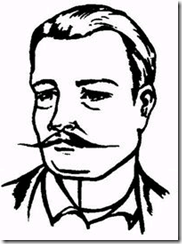
Mustache of a military man who has not lost bearing 10
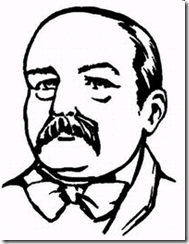
Belarusian mustache 11

Mustache with downcast ends speak of doubt, indecision, weakness 12
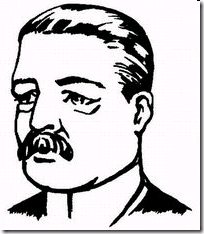
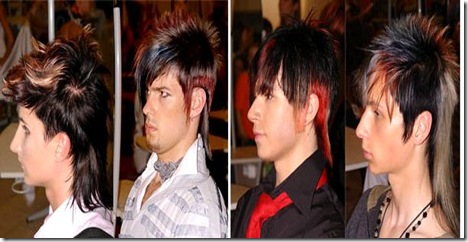
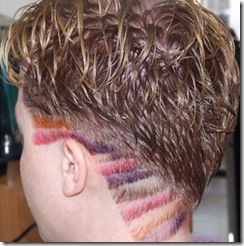
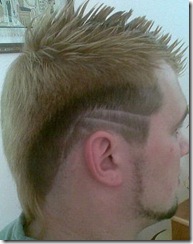
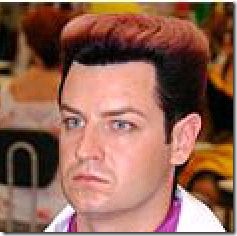
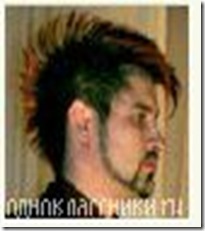

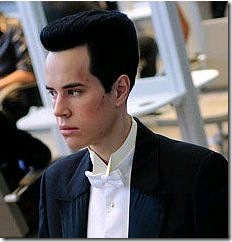
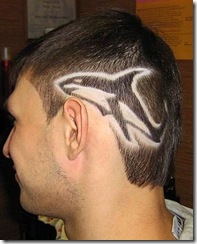
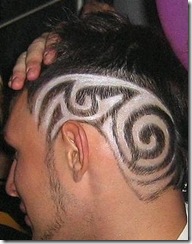


Unlike women, many men do not visit spas or hairdressers so often, and they don’t particularly like to get a haircut, in and of themselves. And some families do it even easier - they cut their hair at home on their own. Therefore, if you suddenly decided to cut your husband or friend yourself, then - here is a short instruction on how to do this step by step. But before that, you need to take into account all the nuances that you will encounter when working with scissors and a machine.
First of all, as an independent home hairdresser, you should understand that absolutely any woman’s or haircut should be as practical as possible. In addition, remember that unlike women, men rarely style their own hair. Therefore, it is so important that at the end of the male haircut, the hairstyle should look pretty without any.
If you are interested in exactly how to evaluate the beauty of a man's haircut, then there are two specific factors:
- How natural and well-groomed are the hair after cutting.
- As far as it is possible to completely completely correct or correct existing hair imperfections.
Further, lessons on the application of the simplest techniques related to hairdressing. With their help you will always achieve the effect you need. It must always be taken into account that there are no two identical types of hair, the shape of the skull and facial features. Often the male half of the population does not pay much attention to the latest fashion news in the fashion world, but nevertheless, zones with different hair lengths may be present on the head , due to which it will be necessary to take into account a certain order of processing of individual zones and how you will select them.

For example, if a person on the crown does not have a lot of curls, then the haircut, ideally, will start from there. If the work in the forehead and temples involves a lot of time, then it would be better to start with the forehead and temples, and then go to the remaining areas. In short, the technique used will always vary, depending on what kind of head in front of you. This will be our next lessons.
The main nuances and features of male hair cutting
It will be better if you start with a lock on your forehead. You need to cut them off with scissors at the level. If you mean any special model haircut, then this condition is not necessary, the level can be both above and below the eyebrows. The next strand should be the hair from the crown. The length directly depends on how thick and stiff hair is in the crown of the head and temples.
The most effective hair remedy, according to our readers, is the unique Hair MegaSpray spray. Trichologists and scientists known around the world had a hand in its creation. The natural vitamin formula of the spray allows it to be used for all types of hair. The product is certified. Beware of fakes. The opinion of hairdressers .. "
The purpose of cutting in the crown is to make a smooth transition between the two strands. At your request, you can choose the direction of movement of the haircut yourself.
This can be done from the top of the head to the face, or, conversely, along or across the profile of the face, the lessons all take this into account. In the process of cutting, it is also necessary to build on the type of parting, they are of two types - horizontal and vertical.
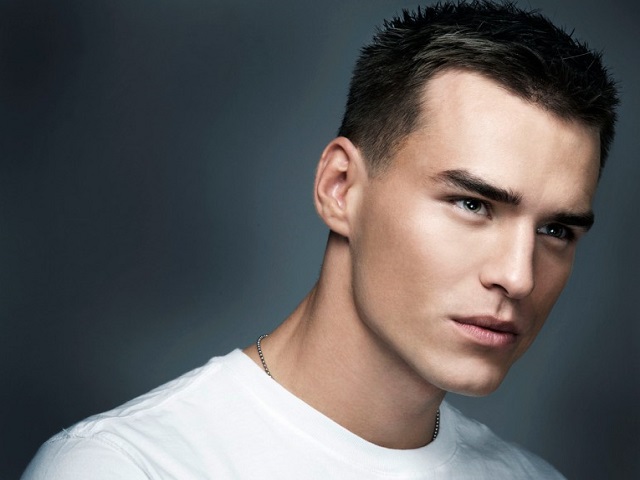
Framing is performed using graduation. Thanks to the application of this method of processing strands on the facial area, a smooth and even transition between the hair on the forehead and all other curls of the crown is obtained. Thus, the hairstyle will receive the effect of additional volume. The sides should be cut vertically, this is necessary so that the hairstyle looks as smooth as possible. The same thing needs to be done with the area on the back of the head, depending on which shape you choose, the back of the head can be cut with scissors at different angles. How to step by step make a classic men's haircut with scissors and a machine? The hairstyle that these lessons consider will be general and sketchy, so it is ideal for any man of any age.
- First you need to carefully comb all the curls from the top of the head down. After that, you need to create a border. Here you need to decide what kind of whiskey your client will have - straight or slanting. The length must also be taken into account. Whiskey should be trimmed so that they can go smoothly to the hair on the side and back of the head. Ears can be opened in whole or in part, it all depends on your vision of the hairstyle.
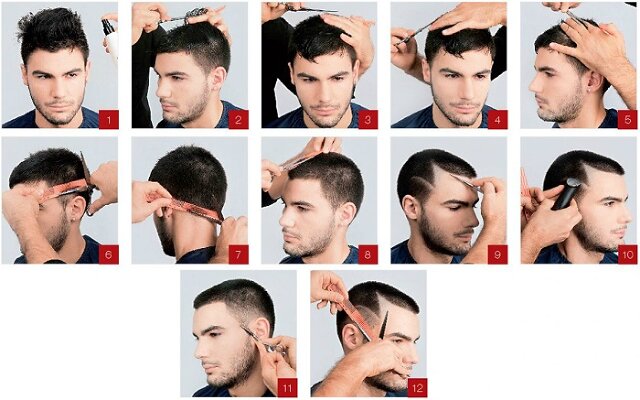
- Make a fringing bangs. The strands should be at the level of the eyebrows or slightly higher. It should be made so that the whiskey smoothly passed to the bangs.
- As soon as you finish the edging, it is necessary to separate the hair from one ear to the other and select two partings on both temples.
- As soon as you get to cutting the crown of the head, you need to step by step to cut from one strand to another. Separate the first strand and comb it on the face of the client - so you can determine how long the bangs will be. The first selected strand will have the same length, which will be the orientation in the process of cutting.
- All remaining strands must be separated using a horizontal parting. The distance between them should be no more than one centimeter. Pull the very first “control” lock 90 degrees from the head. Comb the next one, put it on the same level as the “control” and level it to the level you need. Combine both strands and continue cutting, focusing on them in the future.
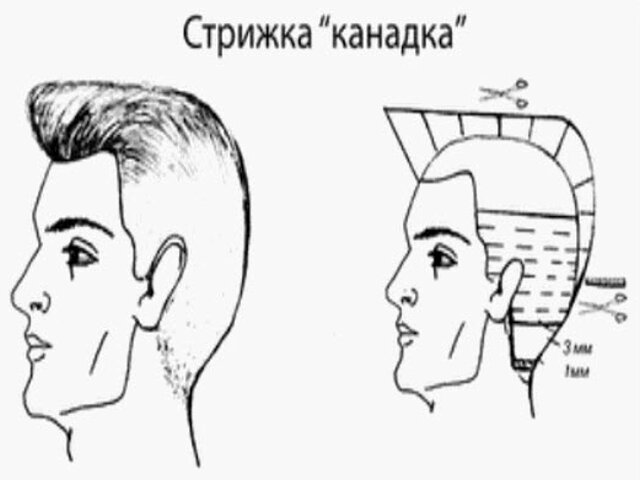
The desire of men to maintain hair in a well-groomed state is growing, therefore, the fashion for men's hairstyles is replaced every season. This year, the classic men's haircut is popular. Fashion designers offer new looks that help express personality.
A person striving for success creates an image not only with the help of clothes, shoes, accessories and perfume, but also with a stylish hairstyle.
Image of a business man
Most men prefer short haircuts that characterize masculinity, while simple, not requiring time for daily styling. When choosing, age, activity and taste are taken into account. Classic men's styling does not age, they are characterized by restraint, neatness, straight lines and simplicity. They are universal, suitable for both businessmen and representatives of creative professions. When choosing them, consider the oval of the face and hair structure.
Each styling has its own characteristics:
- a short haircut does not take time;
- locks middle length, asymmetry requires careful care and laying time;
- owners of thin hair when choosing a classic male hairstyle will have to stop at the shortest version with a thinning to add volume;
- thick and naughty hair will look with a cascading haircut or thinning.
Strict classics of men's hairstyles can be "diluted" with modern elements.
Boxing and semi-boxing
Boxing hairstyle is one of the most common classic ultra-short men's styles. The peak of popularity came in the late 80s and early 90s. It is still relevant.
By structure, the whiskey and the lower part of the nape are shaved up to 3 mm, and the hair length in the upper part is 3-4 cm. Due to the short length, the face remains open. The hairstyle is neat, the shape lasts a long time without requiring adjustment.
The style is suitable for men with the correct shape of the head and straight hair. It is not worth it to choose the owners of curly hair or those who have scars on the scalp.
A variety of hairstyles is a semi-box, characterized by the length of the strands: on the parietal part 6-8 cm, on the remaining sections - up to 5 cm. A bang is left, the length of which depends on the shape of the face and the quality of the hair.
Men with a square or oval type of face can choose the option. It suits holders of a round shape. The half-box is not recommended for men with a thin and elongated face.
The half-box is combined with a business suit and with jeans or t-shirts. This is a youth style that is not extravagant, which allows men aged to choose it.
Hairstyles are convenient to do with a typewriter. It will be required:
- hair clipper with nozzles from 1 to 4 cm;
- thinning shears;
- a comb with small cloves.
Also find out who goes and see. 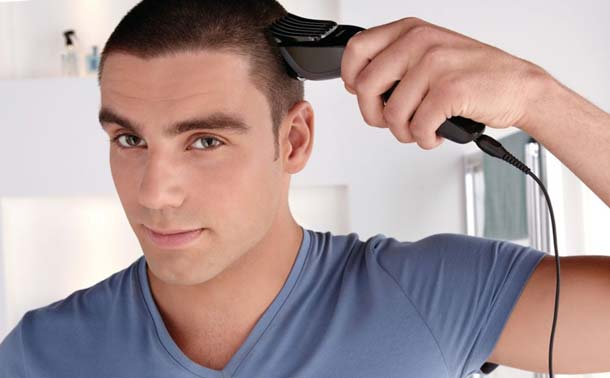
Like a swift:
- We put the nozzle of the minimum length and remove the layer of hair through the upper ends of the ears on the back of the head with the machine. The line is drawn in an arc, in the center - is omitted. First, one side is cut off strip after strip, then the other.
- We make edging on the temples, behind the ears and on the neck.
- Above the shaved area, we process with a thinning shear a small strip along the entire border 2-3 cm wide for a smooth transition from the short part to the long.
- We cut the hair of the parietal part “on the fingers” to the required length, depending on the hairstyle.
- We carry out a thinning.
- You can leave the bangs, or cut it.
We get a hairstyle, as in the photo. Depending on the length of the bangs, you can create different images: with chaotically disheveled strands turn into a dandy, or with a smooth bang on the side, appear as a business person.
Hedgehog and Beaver
"Hedgehog" is a popular variety of comfortable and elegant classic haircut - Tennis. Detailed description and we will present the photo below.
Hairstyle "Hedgehog" is performed according to the scheme: on the sides and on the back of the head, the length of the hair is shortened, and in the upper part, milled strands form a platform. "Highlight" is the long part of the hair in the crown of the head, giving the man the image of a lion. Long strands are attached different directionsthanks to what the elegant, careless and dynamic image turns out.
Hedgehog suits men with an oval face and stiff hair. Owners of soft hair will have to style them with gel or mousse. In the beaver hairstyle, the parietal region is shorter than in the hedgehog. It looks like a flat area with a hair length of about 4 cm.
A tutorial on creating men's classic hairstyles is presented in the video.
Tennis - Elegance and Practicality
Short-cropped hair with a small layer of hair on the top of the head became popular thanks to tennis athletes, being one of the most convenient and versatile men's styles. An extended option is "youth tennis", where styling is carried out by gel.
To get a tennis haircut yourself, you will need:
- machine with nozzles of various lengths;
- razor.
Haircut Stages:
- We take a short nozzle, cut the hair in the temples and the back of the head.
- The parietal region is shear perpendicular, with a guy.
- As an option, in the parietal region we form a “cap”.
- Using a razor, trim the temples and the back of the head.
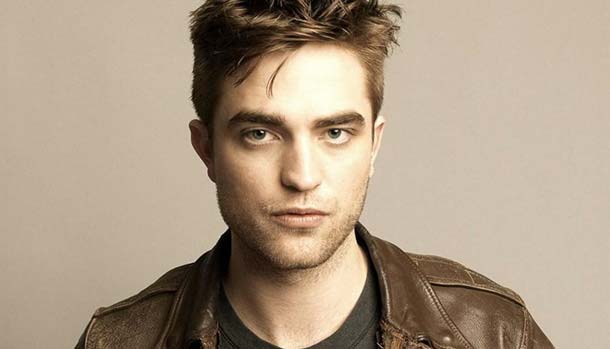
"Tennis" is suitable for both young people and men of respectable age. The physique and type of hair do not matter. The video presented provides a lesson in creating a haircut for beginners.
Canada - style and masculinity
Canada gained popularity in the 70s of the last century, thanks to the hockey players of the Canadian national team. A feature of the haircut was a large volume of hair in the parietal and frontal parts with short hair in the temples and occiput. The transition from the long to the short is smooth, so the hairstyle looks neat.
To create a haircut will require a lot of patience. You can consider the scheme in more detail in the photo. The haircut is universal, but not for everyone - it all depends on the overall style and shape of the face. It goes to holders of oval or round shapes. It can be done on any type of hair, but preferably a wavy hair.
To create a haircut at home will require patience. The technology of the classic men's haircut under the canadian is presented in the video.
British - 50s back in fashion
Widespread in the middle of the last century, the hairstyle is back in fashion. This is a classic men's haircut with a side parting, similar to the "Canadian". For a spectacular look, strands of medium length are needed. The occipital part is shaved off briefly, and the upper part remains long. The bangs are not shortened. Long strands can be laid to one side or combed back, fixed with gel, varnish or mousse. It turns out a stylish image. 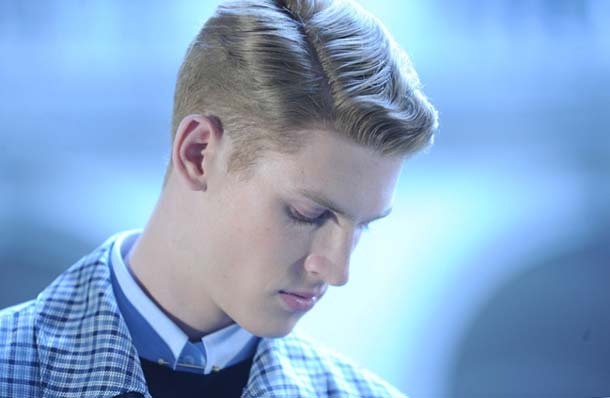
"British" was created for men with curls that add charm to the hairstyle. It suits men with different types of faces: oval, triangular or square. In each case, the hairstyle looks unique, while maintaining individuality.
This haircut with long bangs not recommended for owners of short or sparse hair. Thin ones do not fit either. But there is a way out - perm and varnish will solve the problem. A haircut requires care, so it is not suitable for business people with a shortage of time.
Model haircuts
Classic model men's haircuts are created by a hairdresser, taking into account the wishes of the client, the shape of the face and head. The basic is a regular haircut for short hair, in which the master brings in the elements. This can be a shaved pattern on the back of the head or side, a lock in the form of a “tail” or patterns.
The photo shows examples of the most popular classic model men's haircuts.
To create hairstyles, you can contact the professionals in the beauty salon at the following addresses and find a stylish, original look.


